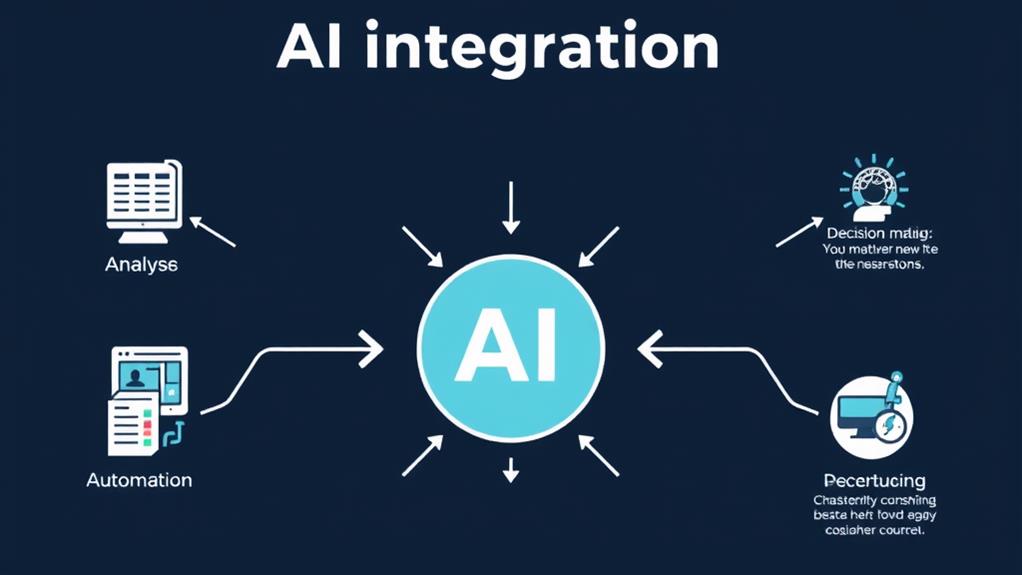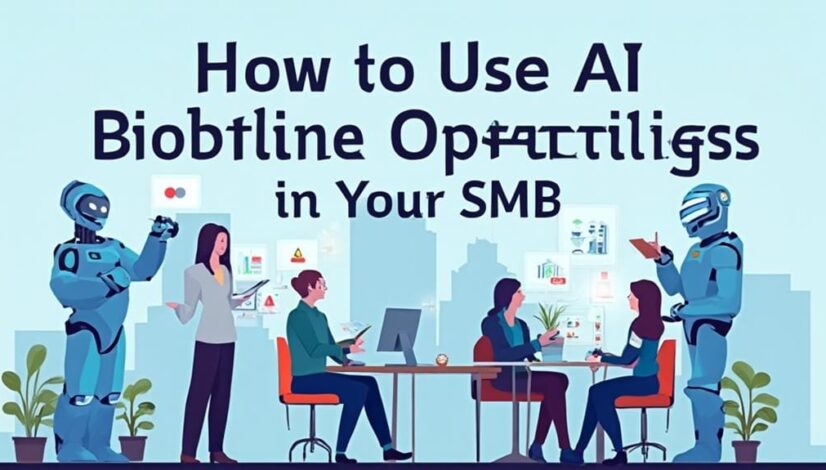How to Use AI to Streamline Operations in Your SMB
To streamline operations in your SMB with AI, start by identifying routine tasks suitable for automation, such as customer support and inventory management. Employ AI tools like chatbots for 24/7 assistance and predictive analytics for demand forecasting. Focus on workflow optimization to enhance efficiency and reduce operational costs. Evaluate potential AI solutions based on your specific needs and guarantee they integrate well with existing systems. Continuous monitoring and employee training are essential for successful implementation. By effectively utilizing AI, you can enable data-driven decision-making and improve overall productivity; there are further strategies that can enhance these efforts.
Key Takeaways
- Implement AI-driven chatbots to enhance customer support, providing 24/7 assistance and allowing human agents to tackle complex issues.
- Utilize predictive analytics for inventory management, improving forecasting accuracy and optimizing supply chain operations.
- Automate repetitive administrative tasks with Robotic Process Automation (RPA), freeing up staff to focus on higher-value activities.
- Leverage advanced data analysis tools to extract actionable insights, empowering informed decision-making and strategic planning.
- Invest in employee training for effective AI integration, ensuring that staff are skilled to utilize new tools and technologies.
Understanding AI in SMBs

In today's rapidly evolving business landscape, small and medium-sized businesses (SMBs) are increasingly recognizing the transformative potential of artificial intelligence (AI) in enhancing operational efficiency. However, understanding AI fundamentals is essential to navigate the complexities surrounding its implementation.
Many SMBs harbor misconceptions, believing that AI is exclusively the domain of large corporations with extensive resources. This belief can hinder their willingness to explore AI integration strategies tailored for smaller operations.
AI integration challenges often stem from a lack of clarity regarding specific use cases, inadequate infrastructure, and insufficient training. To overcome these hurdles, businesses must invest in AI training needs, ensuring that employees are equipped with the skills necessary to leverage AI technologies effectively.
Additionally, organizations must remain cognizant of AI security risks that may arise from data breaches or algorithmic biases, thereby highlighting the importance of robust AI ethics considerations in their strategies.
Engaging in AI trends analysis allows SMBs to stay informed about evolving technologies and their potential applications. This practice not only mitigates the fear of obsolescence but also fosters innovation within the workforce.
Recognizing the AI workforce impact is essential for developing a future-oriented outlook, as businesses prepare for changes in job roles driven by automation.
Ultimately, the future outlook for AI in SMBs hinges on a balanced approach—embracing adoption strategies that prioritize security, ethical considerations, and employee empowerment.
Benefits of AI Implementation
The implementation of AI in operations offers significant advantages, including increased efficiency gains that streamline processes and reduce time spent on manual tasks.
Additionally, AI-driven insights contribute to cost reduction strategies by identifying wasteful expenditures and optimizing resource allocation.
Enhanced decision-making processes, supported by data analytics, empower organizations to make informed choices quickly and accurately.
Increased Efficiency Gains
AI implementation can lead to significant efficiency gains across various organizational functions. By harnessing advanced algorithms for workflow optimization, businesses can streamline processes that were once time-consuming and labor-intensive. This automation not only enhances productivity but also allows employees to concentrate on higher-value tasks, improving overall employee engagement.
Pragmatically, AI tools enable smart resource allocation, ensuring that staff and assets are deployed where they can generate the most impact. Enhanced time management becomes feasible as AI assists in task prioritization, helping teams focus on urgent and important activities without the clutter of less critical tasks. Coupled with real-time performance metrics, companies gain visibility that facilitates informed decision-making.
Moreover, process automation fosters operational scalability. As businesses grow, AI technology integration becomes crucial in maintaining efficiency levels without overwhelming existing frameworks. By adopting AI solutions, SMBs can achieve a delicate balance between agility and robustness, scaling operations while maximizing output.
The implementation of AI represents a transformative strategy that empowers organizations to ascend towards greater efficiency, thereby enhancing their competitive edge in a complex marketplace.
Cost Reduction Strategies
Significant cost reductions are increasingly becoming a tangible benefit of AI implementation. By leveraging advanced algorithms and machine learning, small and medium-sized businesses (SMBs) can conduct thorough cost analysis, pinpointing inefficiencies that may be inflating expenses.
Enhanced operational efficiency is achieved through resource optimization, enabling businesses to allocate their assets more effectively while reducing waste.
Financial forecasting capabilities driven by AI allow organizations to anticipate market trends, facilitating more effective budget management and enabling the timely adjustment of financial strategies. This proactive approach to expense tracking not only safeguards profit margins but also enhances the ability to manage supply chain expenditures effectively.
Furthermore, integrating AI into risk assessment processes assists businesses in identifying potential vulnerabilities before they escalate into costly issues, ensuring a more resilient operational framework.
The overall impact on workforce productivity is profound, as automation of repetitive tasks empowers employees to focus on strategic initiatives that drive growth.
Enhanced Decision-Making Processes
Numerous businesses are discovering that AI implementation can drastically enhance their decision-making processes. With tools such as data visualization, organizations can transform complex datasets into intuitive graphical representations, fostering clarity and quicker comprehension. This allows decision-makers to identify trends and anomalies much more efficiently.
AI-driven scenario modeling enables enterprises to simulate various outcomes based on different variables, facilitating robust risk assessment. This capability empowers leaders to anticipate challenges and make informed choices that mitigate risk.
Additionally, cognitive computing provides advanced analytics that can interpret vast amounts of data through sentiment analysis, capturing customer opinions and preferences in real time.
Incorporating real-time feedback further enriches decision support systems, as companies can adapt strategies promptly in response to market changes. Techniques like collaborative filtering can personalize recommendations, enhancing product offerings and customer satisfaction.
Automated reporting streamlines information dissemination, ensuring that key stakeholders receive actionable insights without delay.
Finally, strategic forecasting harnesses predictive analytics, equipping SMBs with more accurate forecasts, which is essential for long-term planning.
Collectively, these AI capabilities not only refine decision-making but also accelerate growth and innovation within organizations, paving the way for sustained competitive advantage.
Identifying Routine Tasks

In modern workplaces, identifying routine tasks is essential for optimizing efficiency and productivity. Routine tasks, often mundane yet vital, can consume valuable employee time, detracting from more strategic activities. Organizations can benefit immensely from recognizing these tasks, as it allows them to implement effective solutions to streamline operations and free up their workforce for higher-level contributions.
One effective approach to identify routine tasks is to conduct a thorough audit of daily activities within teams. This audit should focus on documenting tasks performed, duration, and frequency. Employing task prioritization techniques can further assist in distinguishing between high-value activities and repetitive, lower-impact tasks. By categorizing tasks based on urgency, importance, and return on investment, it becomes easier to pinpoint those that are ripe for automation or process improvement.
Moreover, integrating workflow optimization methods plays a pivotal role in analyzing interdependencies among tasks. Mapping workflows visually can reveal bottlenecks and redundancies, providing insights into which routine tasks can be refined or eliminated altogether. By concentrating on this analysis, organizations not only enhance their operational flow but also empower employees to engage in more fulfilling work.
Ultimately, identifying routine tasks paves the way for the thoughtful implementation of innovative solutions, enabling small to medium-sized businesses to thrive in an increasingly competitive landscape. A focus on efficiency through the identification of these tasks is not just about immediate gains; it's about fostering an environment that supports creativity and strategic thinking in the long term.
Choosing the Right Tools
While identifying routine tasks is fundamental, selecting the appropriate tools for automation and efficiency enhancement is equally significant for organizations aiming to streamline their operations. A thorough tool evaluation should begin with a clear understanding of specific business needs, considering factors such as user experience and software compatibility.
When evaluating different solutions, feature comparison becomes essential. Organizations should prioritize functions that align with their operational goals while guaranteeing that the selected tools can scale effectively with business growth. Scalability factors relevant to future needs must be analyzed alongside cost considerations to avoid budget overruns.
Integration challenges are common during the adoption of new tools. It's imperative to evaluate how well potential tools integrate with existing systems, as poor compatibility can hinder productivity. Additionally, a successful implementation timeline is necessary; organizations should establish realistic schedules that factor in both technical integration and user training.
Vendor selection plays a significant role in this process. Opt for vendors that provide thorough support and training to guarantee that employees can maximize usage and efficiency. The extent of user training provided should be considered, as adept users are more likely to leverage the full potential of automation tools.
Automating Customer Support

Enhancing customer support through automation represents a strategic opportunity for organizations seeking to improve efficiency and responsiveness. By investing in advanced tools, small and medium businesses (SMBs) can streamline interactions and foster customer satisfaction. One significant method of achieving this is through chatbot integration, which allows businesses to provide round-the-clock assistance without overwhelming human agents.
Chatbots, powered by artificial intelligence, can handle a multitude of customer inquiries—from addressing frequently asked questions to facilitating complex troubleshooting. This not only reduces response times but also frees human agents to focus on more nuanced and high-stakes customer interactions. The ability to efficiently manage routine issues leverages resources effectively, translating to cost savings for the organization.
Moreover, integrating chatbots brings the additional benefit of collecting and analyzing customer feedback in real-time. This feedback can serve as an essential source of insights, enabling businesses to identify areas for improvement, adapt service offerings, and tailor customer experiences. Automating customer support consequently creates a feedback loop that enhances both service quality and operational agility.
Incorporating these AI-driven technologies empowers organizations to achieve a high degree of scalability, allowing them to respond to customer needs swiftly and accurately. By adopting automated customer support solutions, SMBs not only enhance their service delivery but also bolster their competitive edge in a rapidly evolving market landscape.
The effective combination of chatbot integration and proactive customer feedback management can fundamentally transform how organizations engage with their clients, fostering deeper relationships and loyalty.
Enhancing Data Analysis
Enhancing data analysis is critical for informed decision-making and operational efficiency.
By automating data collection, organizations can eliminate manual errors and greatly reduce the time taken to gather insights.
Additionally, incorporating predictive analytics tools allows companies to forecast trends and behaviors, enabling proactive strategies that align with business objectives.
Automating Data Collection
The efficiency of data analysis hinges considerably on the quality and timeliness of data collection.
Automating data collection is essential for small and medium-sized businesses (SMBs) working towards clarity and improved decision-making. Leveraging advanced AI technologies can facilitate this process, allowing organizations to implement effective data gathering strategies and achieve real-time monitoring of essential metrics.
Consider the following benefits of automation in data collection:
- Enhanced Accuracy: Reduces human error through systematic data collection mechanisms.
- Cost-Effective: Minimizes labor overheads associated with manual data entry.
- Increased Speed: Accelerates the collection process, ensuring timely access to critical information.
- Scalability: Adapts seamlessly to growing data needs as your business evolves.
- Improved Insights: Facilitates immediate analysis, enabling more informed decisions.
Predictive Analytics Tools
Building upon the foundation established through automated data collection, organizations can leverage predictive analytics tools to further enhance their data analysis capabilities.
These tools employ predictive modeling to forecast future trends, enabling SMBs to engage in effective demand forecasting and trend analysis. By scrutinizing historical data and identifying patterns, companies can make informed sales predictions, ultimately optimizing inventory management and resource allocation.
Moreover, predictive analytics supports customer segmentation, allowing organizations to tailor marketing efforts to specific demographics, thereby enhancing customer engagement.
Risk assessment features facilitate proactive decision-making by identifying potential threats, while operational insights derived from performance metrics enable continuous improvement of processes.
Scenario planning is essential for preparing for various potential outcomes; this predictive approach fosters agility and responsiveness in a rapidly changing market landscape.
Additionally, anomaly detection assists in monitoring for irregularities within data sets, empowering businesses to address issues before they escalate.
Incorporating predictive analytics tools not only streamlines operations but also promotes a culture of data-driven decision-making, providing SMBs the freedom and flexibility to thrive in competitive environments.
Streamlining Inventory Management

Effective inventory management is vital for maintaining operational efficiency and meeting customer demand while minimizing costs. In today's fast-paced business landscape, small and medium-sized businesses (SMBs) can leverage AI-driven techniques to enhance their inventory processes. By implementing robust inventory forecasting and demand planning, companies can better predict customer requirements and adjust their stock levels accordingly.
AI facilitates supply chain optimization through improved product categorization and inventory visibility, allowing businesses to track stock levels in real-time. This not only enhances order management but also streamlines stock replenishment processes, guaranteeing that products are always available when customers need them.
Additionally, warehouse automation plays an important role in reducing human error and operational delays, thereby greatly boosting productivity.
Consider the following vital elements for effective inventory management:
- Data-Driven Decisions: Utilize AI analytics to inform inventory forecasting and replenishment strategies.
- Optimized Ordering: Automate order management to craft dynamic reorder points based on predictive insights.
- Enhanced Visibility: Employ AI solutions to provide real-time inventory visibility across multiple locations.
- Flexible Supply Chains: Adapt quickly to shifting consumer trends with integrated demand planning tools.
- Proactive Restocking: Guarantee timely stock replenishment through smart algorithms that track sales trends.
Improving Marketing Efforts
In the domain of marketing, AI can greatly enhance operational effectiveness by facilitating targeted audience identification, ensuring that campaigns reach the most relevant consumers.
Automated campaign management further streamlines processes, allowing for efficient execution and real-time adjustments.
Additionally, data-driven insights analysis can illuminate consumer behavior patterns, empowering marketers to make informed decisions that drive business growth.
Targeted Audience Identification
Identifying a targeted audience is essential for enhancing marketing efforts, as it allows businesses to focus their resources on demographics that are most likely to convert.
AI technology aids in this process through effective target audience segmentation and customer persona development, refining marketing strategies by utilizing data-driven insights.
Businesses can harness AI to:
- Analyze customer behaviors and preferences.
- Create detailed customer personas that reflect various demographics.
- Identify trends and patterns that inform product offerings.
- Optimize marketing channels by targeting the right audiences efficiently.
- Enhance return on investment through focused campaigns.
Automated Campaign Management
Once businesses have successfully identified their target audience, the next logical step is to implement automated campaign management. This involves creating structured, automated workflows that streamline marketing efforts, ensuring that messages reach consumers at the right time with minimal manual intervention.
Utilizing AI-driven software can greatly enhance campaign optimization by analyzing user engagement and preferences, leading to more tailored marketing strategies.
Automated workflows enable businesses to schedule emails, social media posts, and other marketing materials efficiently, thereby maximizing reach without overwhelming resources.
These systems can track responses and automatically adjust future campaigns based on performance metrics, allowing for continuous improvement. This data-driven approach not only saves time but also fosters a sense of freedom for marketing teams, allowing them to focus on higher-level strategy rather than routine administrative tasks.
Data-Driven Insights Analysis
Effective marketing strategies increasingly rely on data-driven insights analysis to refine and enhance their efforts. By leveraging advanced AI technologies, small to medium-sized businesses can extract meaningful information from vast datasets, which plays a significant role in improving overall marketing performance.
Employing data-driven methodologies allows organizations to understand user behavior, anticipate trends, and execute targeted campaigns.
To optimize marketing efforts through data-driven insights, consider the following approaches:
- Data Visualization: Simplifies complex data through visual representation, making insights more accessible.
- Trend Forecasting: Identifies potential market trends, enabling proactive strategy adjustments.
- Predictive Modeling: Uses historical data to predict future user behavior, enhancing campaign effectiveness.
- Anomaly Detection: Celebrates and addresses unexpected changes, preventing costs from eroding marketing ROI.
- Reporting Automation: Streamlines data reporting, freeing up resources for creative and strategic initiatives.
Implementing robust data governance and ensuring data cleaning are essential steps to maintain quality and reliability in data integration.
Additionally, real-time analytics empowers marketers to make swift decisions based on evolving consumer needs, ultimately paving the way for more effective marketing efforts that resonate with their audience.
Implementing AI-Powered Analytics

Implementing AI-powered analytics transforms the way organizations harness data, enabling them to draw critical insights that inform strategic decision-making. By utilizing advanced algorithms, businesses can engage in data visualization techniques that simplify complex datasets, making information accessible and actionable. This insight facilitates trend forecasting, allowing companies to predict future market directions and adjust strategies accordingly.
Performance metrics can be monitored in real time, providing organizations with immediate feedback on operational efficiency. With these insights, companies can dive deeper into user behavior, allowing for targeted segmentation analysis that enhances marketing efforts and improves customer engagement. AI-driven tools streamline the reporting process, enabling real-time reporting that keeps decision-makers informed of key developments as they happen.
Furthermore, anomaly detection capabilities aid in identifying outliers and potential issues before they escalate, preserving operational integrity. Competitive benchmarking allows organizations to understand their position within the industry seamlessly, using their data against that of their competitors to uncover areas for growth.
Dashboard integration serves as a centralized hub for these analytics, where all relevant data can be visualized on a single platform. Historical comparisons can also be easily conducted, empowering organizations to learn from their past performance and refine their future strategies accordingly.
In adopting AI-powered analytics, small and medium-sized businesses not only enhance their operational efficiency but also cultivate a culture of informed decision-making that promotes growth and sustainability.
Measuring Success With AI
Measuring success with AI requires a clear framework that aligns data-driven insights with organizational goals. To effectively evaluate AI initiatives within your SMB, it is essential to establish success metrics that provide tangible evidence of progress. This can be accomplished through a robust performance tracking system designed to monitor key indicators consistently.
To streamline the evaluation process, consider incorporating the following components:
- AI Benchmarks: Compare your AI performance against industry standards.
- ROI Analysis: Determine the financial return on your AI investments.
- Outcome Evaluation: Assess if AI-driven changes yield the desired results.
- Impact Assessment: Examine the broader implications of AI initiatives on your operations.
- Feedback Loops: Use continuous feedback to refine strategies and increase effectiveness.
Strategic planning requires a thorough understanding of these elements. Goal alignment guarantees that all AI efforts contribute meaningfully to overarching organizational objectives.
Regular effectiveness measurement allows for agile adjustments, further enhancing the impact of AI technologies on operational workflows.
Incorporating these principles into your AI implementation strategy will foster a culture of accountability and continuous improvement. By focusing on precise metrics and quantitative analysis, your business can adapt and thrive in an ever-evolving landscape, ultimately achieving the freedom to innovate.
Successful AI integration hinges upon clear guidelines and ongoing assessment, enabling SMBs to harness the full potential of artificial intelligence while enhancing overall operational efficiency.
How Can Starting Your AI Journey Help Streamline Operations in Your SMB?
Starting ai journey can transform how small and medium-sized businesses manage daily operations. By automating repetitive tasks, improving data analysis, and enhancing decision-making processes, AI optimizes efficiency and reduces operational costs. This strategic step empowers SMBs to focus on growth, customer satisfaction, and innovation while staying competitive in a fast-evolving marketplace.
Frequently Asked Questions
What Are the Costs Associated With Implementing AI in Smbs?
The costs associated with implementing AI in small to mid-sized businesses (SMBs) encompass an initial investment and ongoing maintenance.
The initial investment typically includes software acquisition, infrastructure upgrades, and personnel training. These upfront expenses can be significant and require careful budget planning.
Ongoing maintenance costs involve software updates, system monitoring, and technical support, ensuring peak performance and user satisfaction.
A thorough understanding of these financial implications is essential for informed decision-making and long-term sustainability.
How Can Employees Adapt to AI Integration Within Their Roles?
As the saying goes, "Change is the only constant." In the face of AI integration, employees must undergo thorough training to embrace role transformation effectively.
Focused employee training programs should prioritize skill development and adaptability, ensuring team members become proficient in AI tools.
Are There Risks Involved in Using AI for Business Operations?
Utilizing AI in business operations does present notable risks, particularly concerning ethical considerations and potential biases inherent in algorithms.
Organizations must proactively implement bias mitigation strategies to guarantee equitable outcomes and maintain stakeholder trust.
Additionally, there is the risk of over-reliance on automated systems, which may impair decision-making capabilities.
Consequently, businesses should adopt a balanced approach, ensuring that AI complements human oversight to mitigate these risks effectively.
Which Industries Benefit the Most From AI in Smbs?
Just as the Renaissance birthed transformative ideas across various fields, today's industries are reshaping their trajectories through AI.
Sectors such as healthcare benefit from enhanced diagnostic capabilities, while retail thrives on personalized shopping experiences.
Manufacturing sees efficiency improvements, whereas finance leverages AI for more accurate forecasting.
Moreover, customer service automation enhances interactions, and logistics optimization drives timely deliveries.
These advancements underscore AI's pivotal role in enabling freedom and innovation within small and medium-sized businesses.
How Can I Ensure Data Privacy While Using AI Tools?
Ensuring data privacy while leveraging AI tools necessitates implementing robust measures such as data encryption and secure storage solutions.
User consent is paramount, requiring transparency about data usage and compliance with privacy regulations.
Additionally, organizations should conduct thorough risk assessments to identify vulnerabilities.
Ethical considerations must guide AI integration, ensuring that any data processing aligns with the principles of privacy and security.
Ultimately, a thorough approach fosters trust and protects user confidentiality in AI applications.
Conclusion
In summary, the integration of artificial intelligence within small and medium-sized businesses offers a transformative potential that transcends mere operational efficiency. Embracing AI is akin to revealing a treasure chest of insights and capabilities, enabling organizations to not only streamline routine functions but also enhance strategic decision-making. As the landscape of commerce continues to evolve, those who harness the power of AI will find themselves not merely surviving, but thriving amidst the competitive currents of the market.




